The Extended SLM Combined Autoencoder of the PAPR Reduction Scheme in DCO-OFDM Systems
Abstract
Featured Application
Abstract
1. Introduction
2. Methods
2.1. An Overview of the DCO-OFDM System Model
2.2. The ESLM-AE PAPR Reduction Scheme
2.2.1. Autoencoder Network
2.2.2. Extended Selected Mapping Technique
3. Results and Discussion
3.1. PAPR Comparison
3.2. BER Analysis
4. Conclusions
Author Contributions
Funding
Conflicts of Interest
References
- Armstrong, J.; Schmidt, B.J. Comparison of asymmetrically clipped optical OFDM and DC-biased optical OFDM in AWGN. IEEE Commun. Lett. 2008, 12, 343–345. [Google Scholar] [CrossRef]
- Komine, T.; Nakagawa, M. Fundamental analysis for visible-light communication system using LED lights. IEEE Trans. Consum. Electron. 2004, 50, 100–107. [Google Scholar] [CrossRef]
- Lu, H.; Hong, Y.; Chen, L.-K.; Wang, J. On the study of the relation between linear/nonlinear PAPR reduction and transmission performance for OFDM-based VLC systems. Opt. Express 2018, 26, 13891–13901. [Google Scholar] [CrossRef] [PubMed]
- Deng, L.; Fan, Y.; Zhao, Q. A novel PAPR reduction scheme for VLC DCO-OFDM systems. Opt. Commun. 2018, 426, 164–169. [Google Scholar] [CrossRef]
- Singh, V.K.; Dalal, U.D. Abatement of PAPR for ACO-OFDM deployed in VLC systems by frequency modulation of the baseband signal forming a constant envelope. Opt. Commun. 2017, 393, 258–266. [Google Scholar] [CrossRef]
- Vgenopoulou, V.; Song, M.; Pincemin, E.; Jaouën, Y.; Sygletos, S.; Roudas, I. Comparison of Nonlinear Compensation Techniques for 400-Gb/s Coherent Multi-Band OFDM Super-Channels. Appl. Sci. 2018, 8, 447. [Google Scholar] [CrossRef]
- Tang, R.; Zhou, X.; Wang, C.; Haar, A. Wavelet Decision Feedback Channel Estimation Method in OFDM Systems. Appl. Sci. 2018, 8, 877. [Google Scholar] [CrossRef]
- Goebel, B.; Hellerbrand, S.; Haufe, N.; Hanik, N. PAPR reduction techniques for coherent optical OFDM transmission. In Proceedings of the 11th International Conference on Transparent Optical Networks (ICTON’09), Azores, Portugal, 28 June–2 July 2009; pp. 1–4. [Google Scholar]
- Lu, H.; Zhang, L.; Wu, Z. Noise Resistant Spreading OOFDM Design for Suppressing PAPR of High Data Rate Wireless Optical Communication System. In Proceedings of the 2018 IEEE International Conference on Communications (ICC), Kansas City, MO, USA, 20–24 May 2018; pp. 1–6. [Google Scholar]
- Chronopoulos, S.K.; Christofilakis, V.; Tatsis, G.; Kostarakis, P. Reducing peak-to-average power ratio of a turbo coded OFDM. Wirel. Eng. Technol. 2012, 3, 195. [Google Scholar] [CrossRef]
- Han, S.H.; Lee, J.H. PAPR reduction of OFDM signals using a reduced complexity PTS technique. IEEE Signal Process. Lett. 2004, 11, 887–890. [Google Scholar] [CrossRef]
- Liu, Y.; Deng, H.; Ren, S.; Tang, C.; Qian, X. Peak-to-average power ratio reduction in orthogonal frequency division multiplexing-based visible light communication systems using a modified partial transmit sequence technique. Opt. Eng. 2018, 57, 016108. [Google Scholar] [CrossRef]
- Zhang, H.; Yuan, Y.; Xu, W. PAPR reduction for DCO-OFDM visible light communications via semidefinite relaxation. IEEE Photonics Technol. Lett. 2014, 26, 1718–1721. [Google Scholar] [CrossRef]
- Hei, Y.; Liu, J.; Li, W.; Xu, X.; Chen, R.T. Branch and bound methods based tone injection schemes for PAPR reduction of DCO-OFDM visible light communications. Opt. Express 2017, 25, 595–604. [Google Scholar] [CrossRef] [PubMed]
- Hei, Y.; Liu, J.; Gu, H.; Li, W.; Xu, X.; Chen, R.T. Improved TKM-TR methods for PAPR reduction of DCO-OFDM visible light communications. Opt. Express 2017, 25, 24448–24458. [Google Scholar] [CrossRef] [PubMed]
- Popoola, W.O.; Ghassemlooy, Z.; Stewart, B.G. Pilot-assisted PAPR reduction technique for optical OFDM communication systems. J. Lightw. Technol. 2014, 32, 1374–1382. [Google Scholar] [CrossRef]
- Yu, B.; Zhang, H.; Wei, L.; Song, J. Subcarrier grouping OFDM for visible-light communication systems. IEEE Photonics J. 2015, 7, 1–12. [Google Scholar] [CrossRef]
- Musumeci, F.; Rottondi, C.; Nag, A.; Macaluso, I.; Zibar, D.; Ruffini, M.; Tornatore, M. A Survey on Application of Machine Learning Techniques in Optical Networks. arXiv, 2018; arXiv:1803.07976. [Google Scholar]
- O’Shea, T.J.; Hoydis, J. An introduction to machine learning communications systems. arXiv, 2017; arXiv:1702.00832. [Google Scholar]
- Dörner, S.; Cammerer, S.; Hoydis, J.; ten Brink, S. Deep learning based communication over the air. IEEE J. Sel. Top. Signal Process. 2018, 12, 132–143. [Google Scholar] [CrossRef]
- Ye, H.; Li, G.Y.; Juang, B.-H. Power of deep learning for channel estimation and signal detection in OFDM systems. IEEE Wirel. Commun. Lett. 2018, 7, 114–117. [Google Scholar] [CrossRef]
- Kim, M.; Lee, W.; Cho, D.-H. A Novel PAPR Reduction Scheme for OFDM System Based on Deep Learning. IEEE Commun. Lett. 2018, 22, 510–513. [Google Scholar] [CrossRef]
- O’Shea, T.J.; Karra, K.; Clancy, T.C. Learning to communicate: Channel auto-encoders, domain specific regularizers, and attention. In Proceedings of the 2016 IEEE International Symposium on Signal Processing and Information Technology (ISSPIT), Limassol, Cyprus, 12–14 December 2016; pp. 223–228. [Google Scholar]
- Felix, A.; Cammerer, S.; Dörner, S.; Hoydis, J.; ten Brink, S. OFDM-Autoencoder for End-to-End Learning of Communications Systems. arXiv, 2018; arXiv:1803.05815. [Google Scholar]
- Sohn, I. A low complexity PAPR reduction scheme for OFDM systems via neural networks. IEEE Commun. Lett. 2014, 18, 225–228. [Google Scholar] [CrossRef]
- Sohn, I.; Kim, S.C. Neural network based simplified clipping and filtering technique for PAPR reduction of OFDM signals. IEEE Commun. Lett. 2015, 19, 1438–1441. [Google Scholar] [CrossRef]
- Csáji, B.C. Approximation with artificial neural networks. Fac. Sci. Etvs Lornd Univ. Hung. 2001, 24, 48. [Google Scholar]
- Hinton, G.E.; Salakhutdinov, R.R. Reducing the dimensionality of data with neural networks. Science 2006, 313, 504–507. [Google Scholar] [CrossRef] [PubMed]
- Vaiyamalai, S.; Mahesula, S.; Dhamodharan, S.K. PAPR Reduction in SLM–OFDM System Using Lehmer Sequence Without Explicit Side Information. Wirel. Pers. Commun. 2017, 97, 5527–5542. [Google Scholar] [CrossRef]
- Elgala, H.; Mesleh, R.; Haas, H. An LED model for intensity-modulated optical communication systems. IEEE Photonics Technol. Lett. 2010, 22, 835–837. [Google Scholar] [CrossRef]
- Azim, A.W.; le Guennec, Y.; Maury, G. Decision-directed iterative methods for PAPR reduction in optical wireless OFDM systems. Opt. Commun. 2017, 389, 318–330. [Google Scholar] [CrossRef]
- Ghassemlooy, Z.; Ma, C.; Guo, S. PAPR reduction scheme for ACO-OFDM based visible light communication systems. Opt. Commun. 2017, 383, 75–80. [Google Scholar]
- O’Shea, T.; Hoydis, J. An introduction to deep learning for the physical layer. IEEE Trans. Cogn. Commun. Netw. 2017, 3, 563–575. [Google Scholar] [CrossRef]
- Ito, Y. Representation of functions by superpositions of a step or sigmoid function and their applications to neural network theory. Neural Netw. 1991, 4, 385–394. [Google Scholar] [CrossRef]
- Srivastava, N.; Hinton, G.; Krizhevsky, A.; Sutskever, I.; Salakhutdinov, R. Dropout: A simple way to prevent neural networks from overfitting. J. Mach. Learn. Res. 2014, 15, 1929–1958. [Google Scholar]
- Taşpınar, N.; Yıldırım, M. A novel parallel artificial bee colony algorithm and its PAPR reduction performance using SLM scheme in OFDM and MIMO-OFDM systems. IEEE Commun. Lett. 2015, 19, 1830–1833. [Google Scholar] [CrossRef]
- Yuan, J.-G.; Shen, Q.; Wang, J.-X.; Wang, Y.; Lin, J.-Z.; Pang, Y. A novel improved SLM scheme of the PAPR reduction technology in CO-OFDM systems. Optoelectron. Lett. 2017, 13, 138–142. [Google Scholar] [CrossRef]
- Chronopoulos, S.K.; Tatsis, G.; Raptis, V.; Kostarakis, P. Enhanced PAPR in OFDM without deteriorating BER performance. Int. J. Commun. Netw. Syst. Sci. 2011, 4, 164. [Google Scholar] [CrossRef]
- Goodfellow, I.; Bengio, Y.; Courville, A.; Bengio, Y. Deep Learning; MIT Press: Cambridge, MA, USA, 2016. [Google Scholar]
- Nair, V.; Hinton, G.E. Rectified linear units improve restricted boltzmann machines. In Proceedings of the 27th International Conference on Machine Learning (ICML-10), Haifa, Israel, 21–24 June 2010; pp. 807–814. [Google Scholar]
- Hu, W.-W.; Lee, D.-H. PAPR Reduction for Visible Light Communication Systems Without Side Information. IEEE Photonics J. 2017, 9, 1–11. [Google Scholar] [CrossRef]
- Chronopoulos, S.K.; Christofilakis, V.; Tatsis, G.; Kostarakis, P. Preliminary BER study of a TC-OFDM system operating under noisy conditions. J. Eng. Sci. Technol. Rev. 2016, 9, 13–16. [Google Scholar] [CrossRef]
- Yang, B.; Letaief, K.B.; Cheng, R.S.; Cao, Z. Channel estimation for OFDM transmission in multipath fading channels based on parametric channel modeling. IEEE Trans. Commun. 2001, 49, 467–479. [Google Scholar] [CrossRef]
- Chy, D.K.; Khaliluzzaman, M. Evaluation of SNR for AWGN Rayleigh and Rician Fading Channels Under DPSK Modulation Scheme with Constant BER. Int. J. Wirel. Commun. Mob. Comput. 2015, 3, 7–12. [Google Scholar]
- Ndjiongue, A.R.; Ngatched, T.M.; Ferreira, H.C. On the Indoor VLC Link Evaluation Based on the Rician K-Factor. IEEE Commun. Lett. 2018, 22, 2254–2257. [Google Scholar] [CrossRef]
- Wilson, S.K.; Holliday, J. Scheduling methods for multi-user optical wireless asymmetrically-clipped OFDM. J. Commun. Netw. 2011, 13, 655–663. [Google Scholar] [CrossRef]
- Carruthers, J.B.; Kahn, J.M. Modeling of nondirected wireless infrared channels. IEEE Trans. Commun. 1997, 45, 1260–1268. [Google Scholar] [CrossRef]

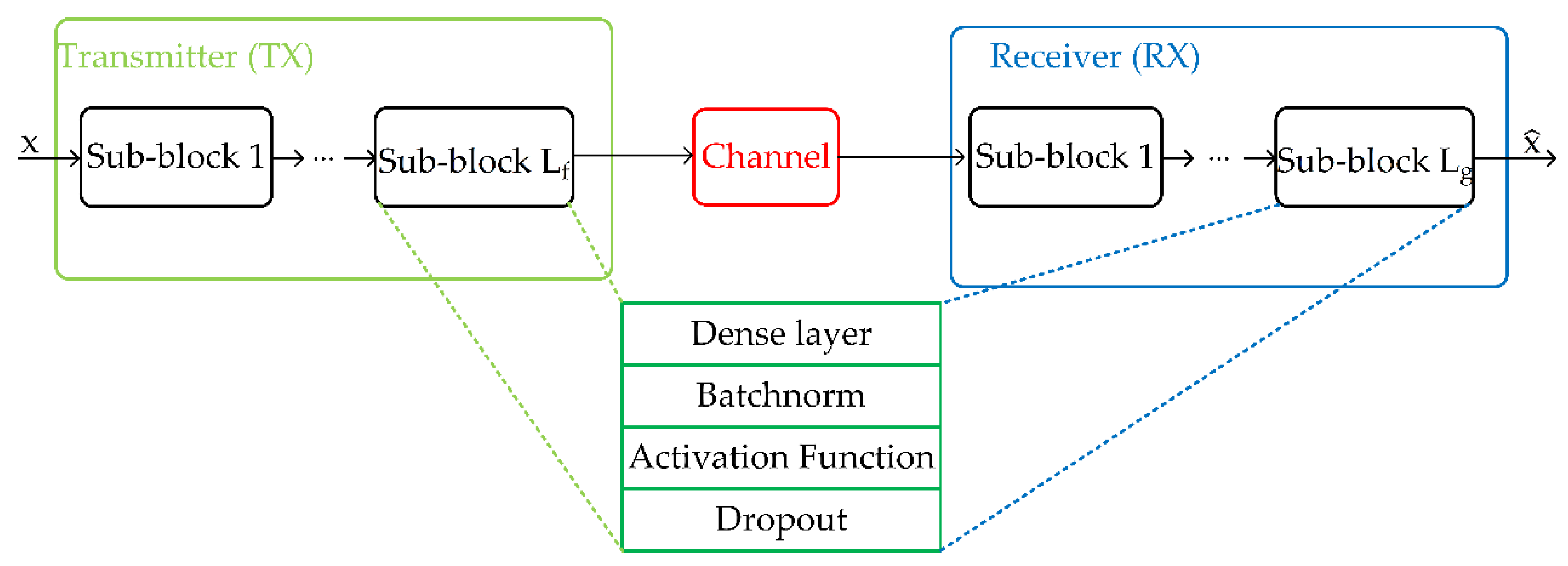

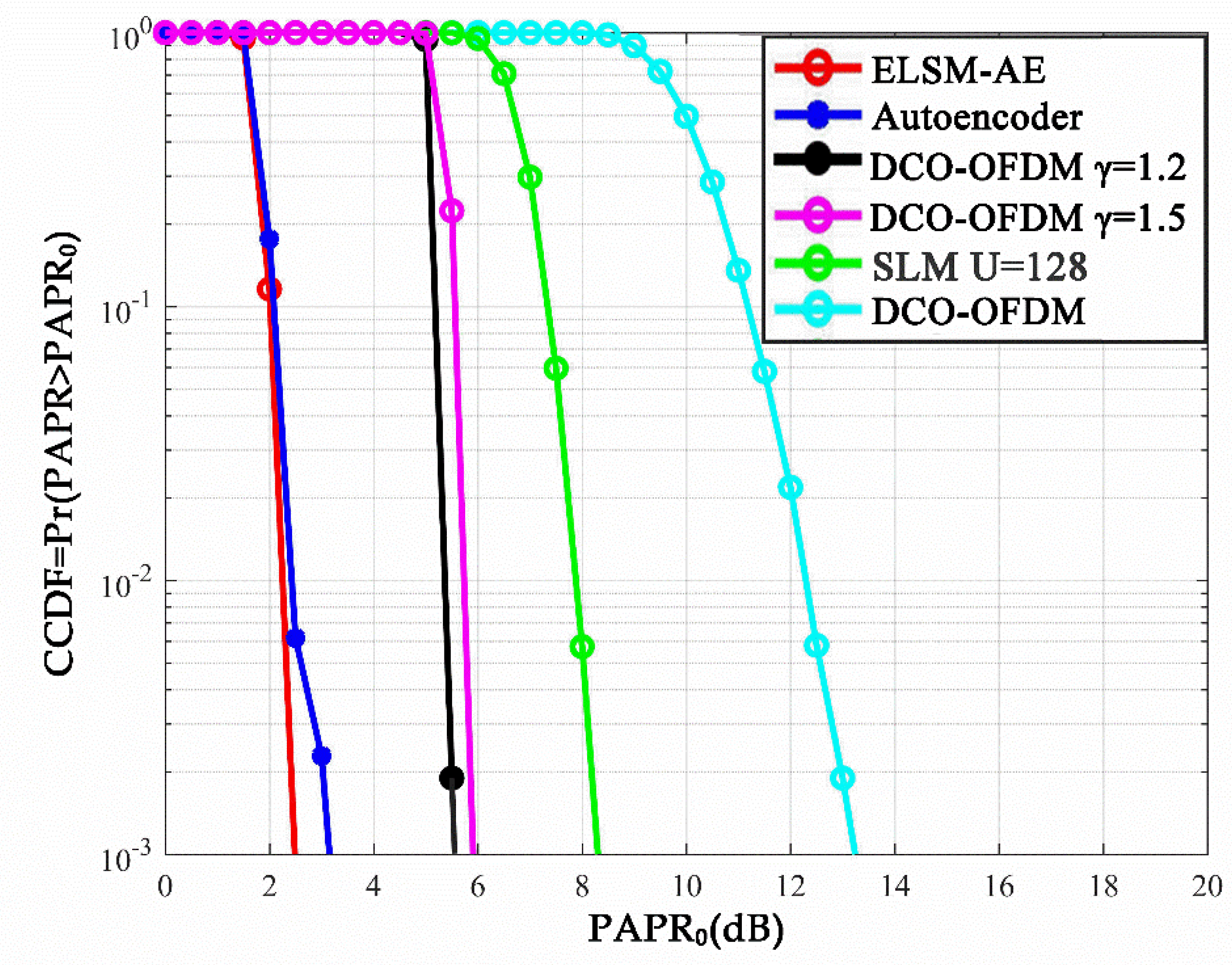
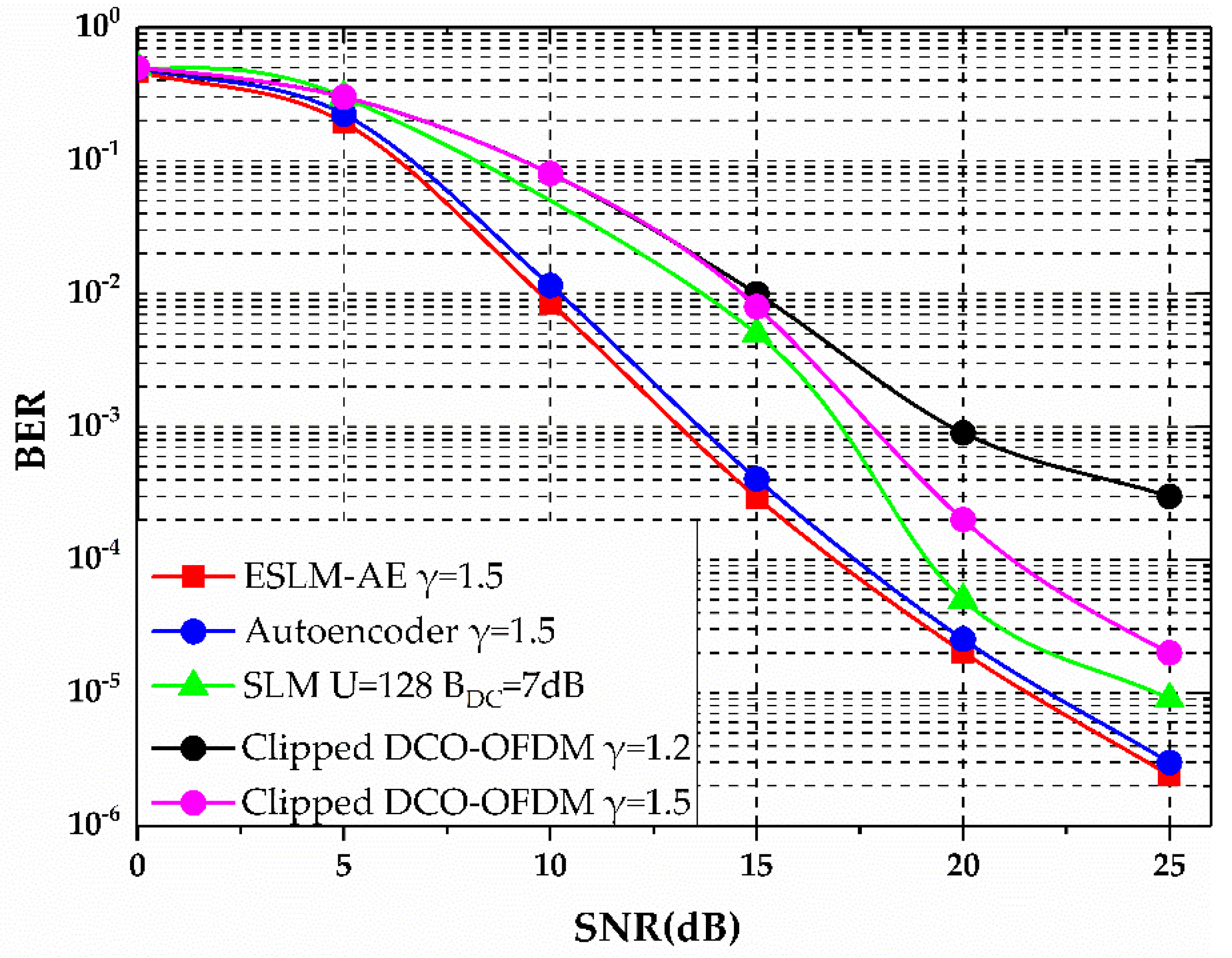
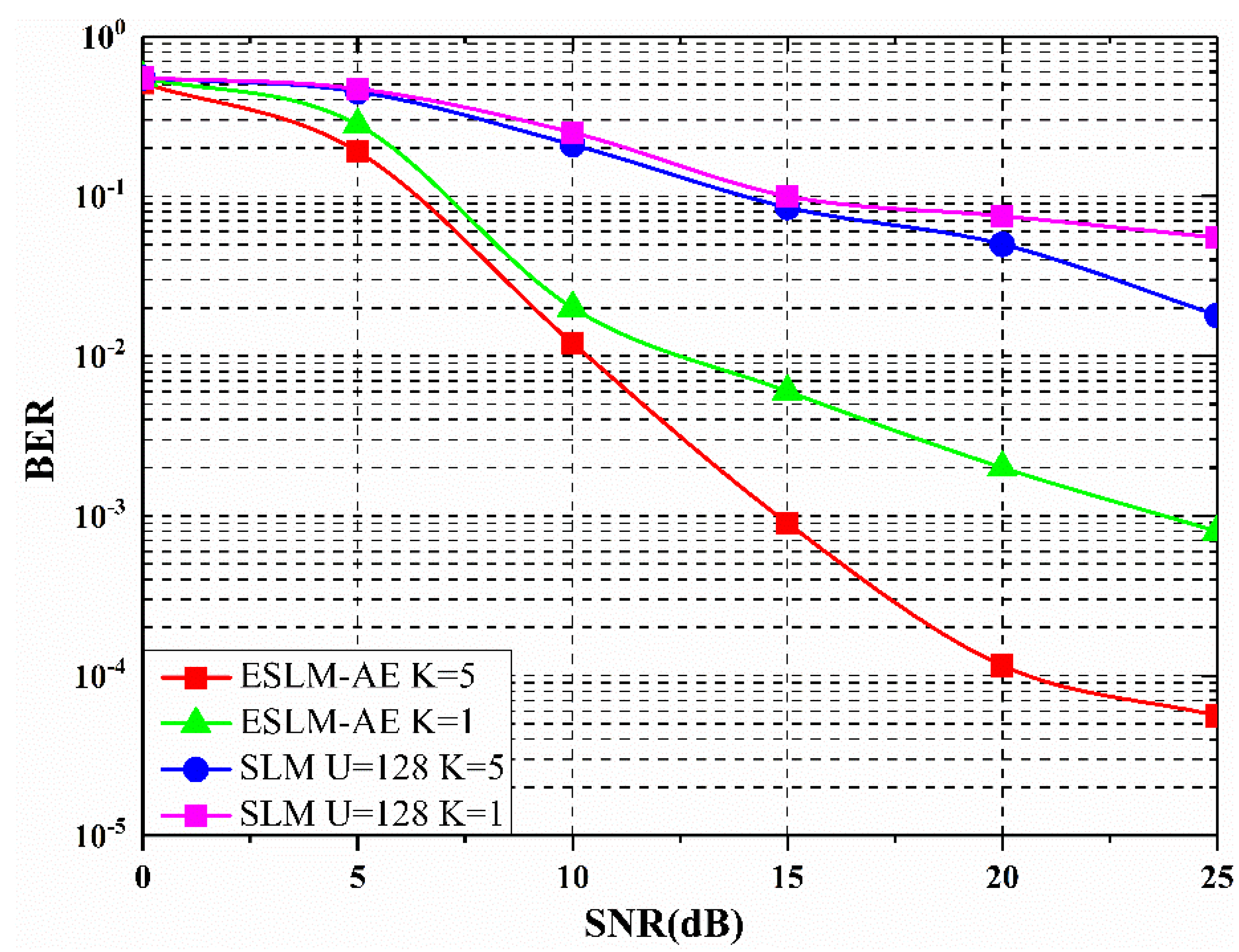
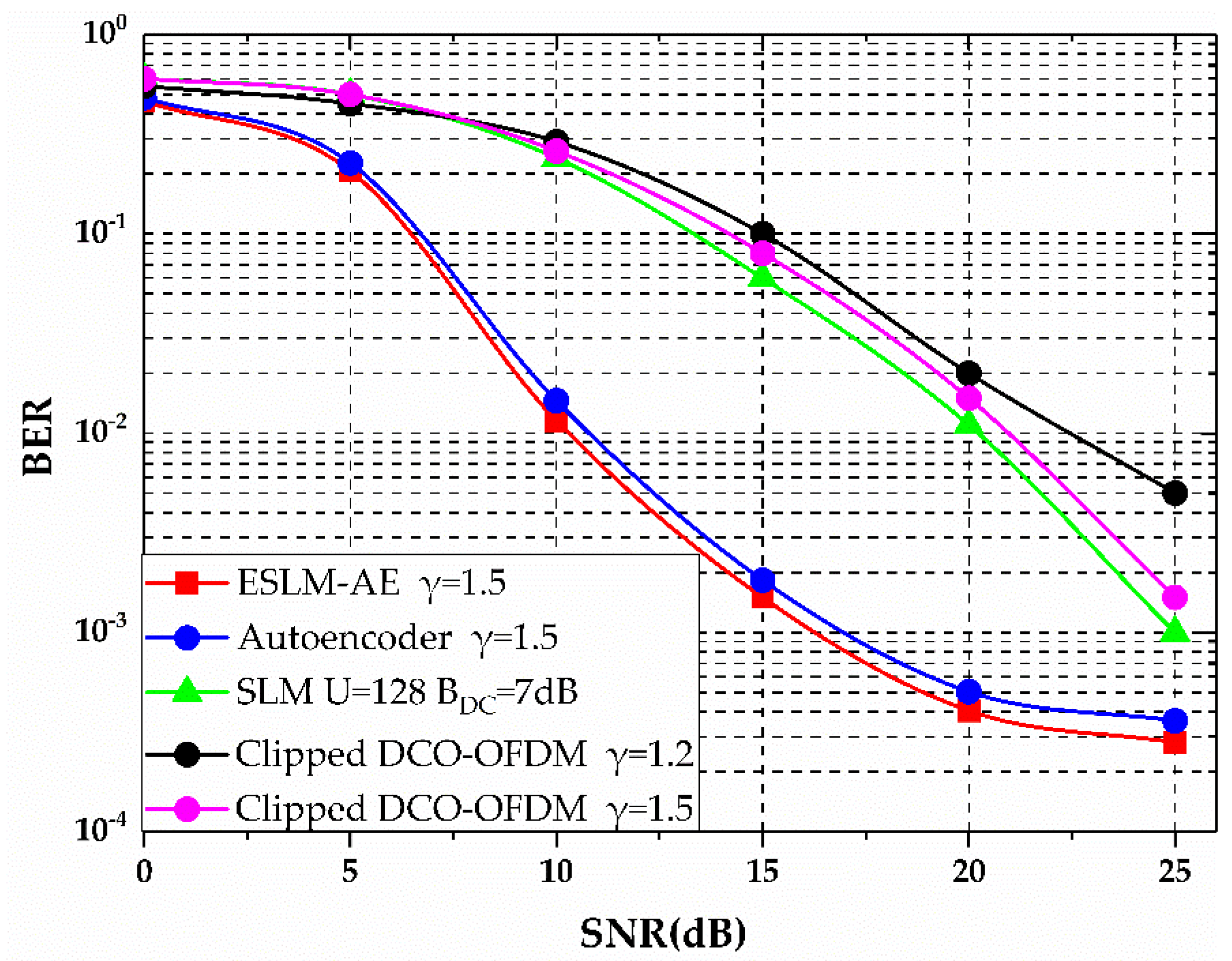
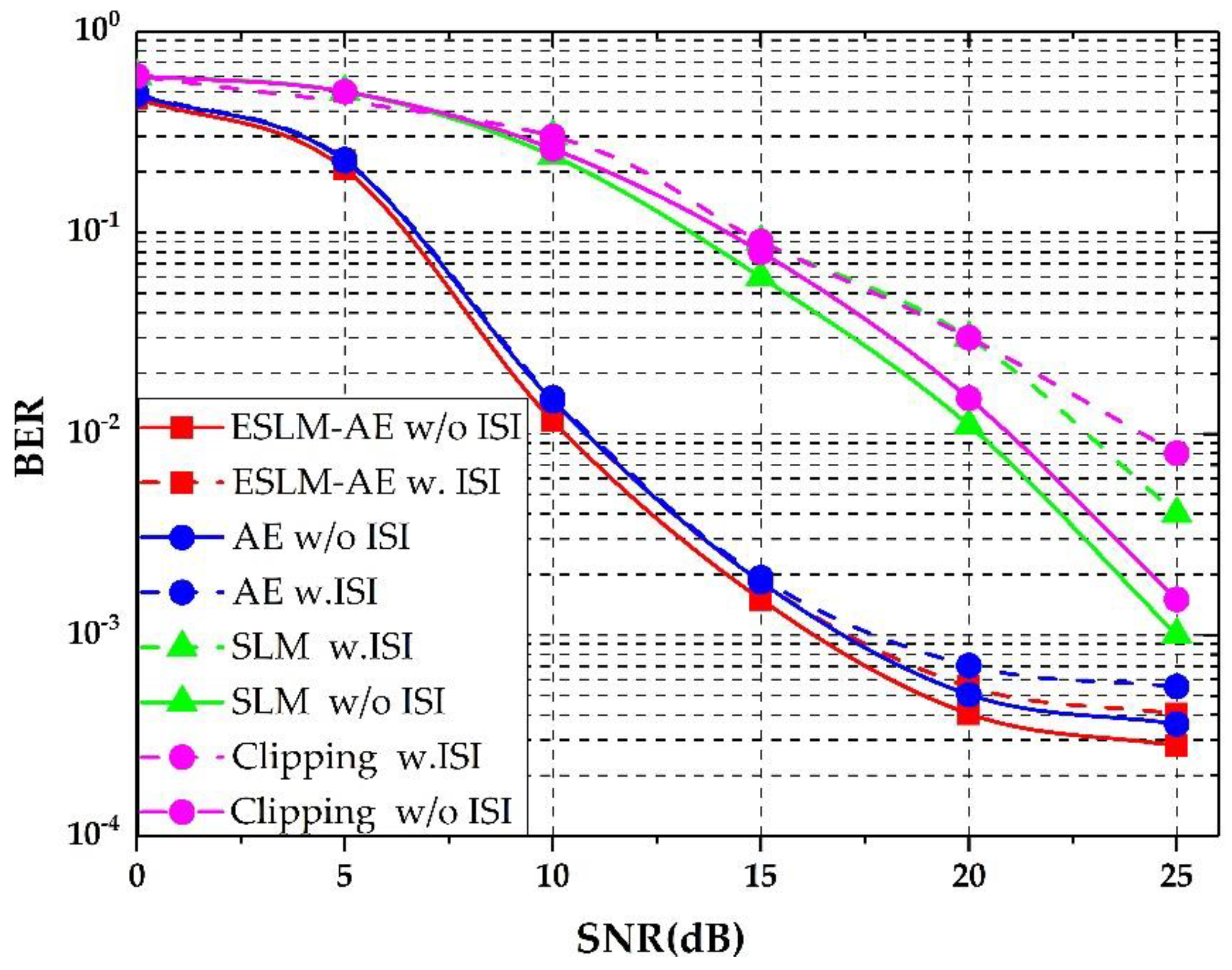
| Parameter | Value |
|---|---|
| Transmitter (TX) dimensions | |
| Input | 128 |
| Dense (ReLU) | 2048 |
| Dense (ReLU) | 2048 |
| Dense (ReLU) | 128 |
| Receiver (RX) dimensions | |
| Input | 128 |
| Dense (ReLU) | 2048 |
| Dense (ReLU) | 2048 |
| Dense (sigmoid) | 128 |
| Optimizer | SGD with Adam [40] |
| Learning rate | 0.0001 |
| Batch size | 32 |
| Weight parameter Dropout probability | 0.01 0.1 |
| Number of subcarriers | 128 |
| Length of cyclic prefix | 32 |
| Results | Average PAPR | BER |
|---|---|---|
| Training set | 2.0198 | 0.0003976 |
| Validation set | 2.0499 | 0.0004077 |
| Test set | 2.0439 | 0.0004059 |
© 2019 by the authors. Licensee MDPI, Basel, Switzerland. This article is an open access article distributed under the terms and conditions of the Creative Commons Attribution (CC BY) license (http://creativecommons.org/licenses/by/4.0/).
Share and Cite
Hao, L.; Wang, D.; Tao, Y.; Cheng, W.; Li, J.; Liu, Z. The Extended SLM Combined Autoencoder of the PAPR Reduction Scheme in DCO-OFDM Systems. Appl. Sci. 2019, 9, 852. https://doi.org/10.3390/app9050852
Hao L, Wang D, Tao Y, Cheng W, Li J, Liu Z. The Extended SLM Combined Autoencoder of the PAPR Reduction Scheme in DCO-OFDM Systems. Applied Sciences. 2019; 9(5):852. https://doi.org/10.3390/app9050852
Chicago/Turabian StyleHao, Lili, Dongyi Wang, Yang Tao, Wenyong Cheng, Jing Li, and Zehan Liu. 2019. "The Extended SLM Combined Autoencoder of the PAPR Reduction Scheme in DCO-OFDM Systems" Applied Sciences 9, no. 5: 852. https://doi.org/10.3390/app9050852
APA StyleHao, L., Wang, D., Tao, Y., Cheng, W., Li, J., & Liu, Z. (2019). The Extended SLM Combined Autoencoder of the PAPR Reduction Scheme in DCO-OFDM Systems. Applied Sciences, 9(5), 852. https://doi.org/10.3390/app9050852







